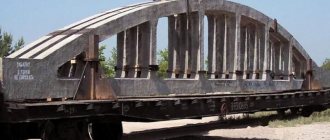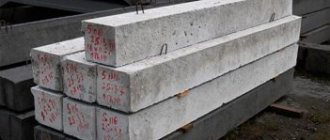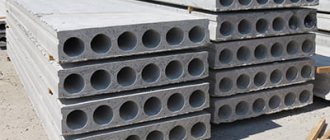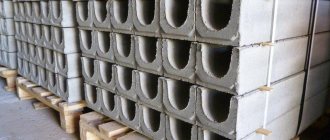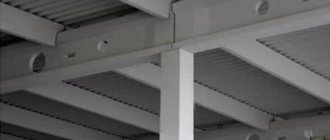Calculation features
Considering the importance of the functions performed by trusses and trusses, the process of their calculation, design and installation must be taken as seriously as possible. The slightest inaccuracy can ruin the entire structure (read also the article “Concrete breaker: how you can make money with this tool, how to choose it and what to look for when buying”).
Elements made of reinforced concrete last the longest and most reliably. However, the complexity of installation coupled with the large final weight limits the use of this type of rafters. They are most often used in unusual cases, when, for example, it is necessary to make a one-story building of a large area.
Reinforced concrete trusses of various sizes
When calculating, not everything is as easy as it might seem at first glance. Therefore, to implement it, a certain amount of knowledge is necessary. In this case, GOST 20213 89 is used for trusses made of reinforced concrete.
Advice: it is very important not to miss a single factor that can have a direct or indirect impact on the final strength properties.
That is why such calculations should be carried out at the design stage by people well acquainted with this area. Every detail is important here - from the choice of the rafter design itself to the choice of small connecting elements.
Three factors must be taken into account in the calculations:
- The total mass of the structure, which includes the weight of the roofing covering and the weight of the rafter system.
- The weight of loads that may additionally arise during operation (snow, wind, etc.).
- The weight of periodic loads (various climatic phenomena or random factors).
Extreme accuracy during calculations will help not only save the overall cost, but also make the object as protected as possible from all kinds of destruction.
Reinforced concrete trusses with parallel chords
The instructions require the use of high-precision equipment for the manufacture of reinforced concrete trusses that can perform the work with minimal errors. When installing rafters, it is especially important to securely fasten all elements so that the stability of the object is not reduced.
Reinforced concrete trusses
Such structures can vary significantly in appearance, based on their parameters, including the coating material used and the methods of supporting them. With their help, it is possible to erect structures with huge spans (more than 24 m). In addition, the roof can be pitched or low-slope, and lanterns can be used on the roof of the structures.
Reinforced concrete truss 24 meters
Advice: use similar reinforced concrete trusses when constructing warehouses and other industrial premises.
The main advantages of such structures:
- high strength qualities;
- good rigidity;
- resistance to low temperatures;
- resistance to aggressive environments;
- fire safety.
Skeleton of the structure
Manufacturing of concrete elements of load-bearing structures
For the production of reinforced concrete trusses, structural type concrete (light or heavy) is used, most often agloporite concrete or expanded clay concrete. The manufacturing process itself is carried out in test chambers with one or several tiers, on which steel molds with a steam jacket are mounted.
To create racks and braces laid during reinforcement, vibrating tables with special cassette forms are used.
In the photo - reinforced concrete beams and reinforced concrete trusses
Conventional rods are most often used as the upper chord for reinforcement, but the lower chords are equipped with high-strength wire, Ø 5 mm, which is assembled into string packages. To tension the latter, it is necessary to use hydraulic jacks, after which concrete mixture is added there.
After 2-3 hours, the product is sent to the heat treatment workshop. At each manufacturing process, quality control of pre-stressed products is carried out.
Labeling process
To mark such material, letters and numbers written with a hyphen are used.
Letters indicate the size and type of workpiece, and numbers display, including:
- additional information;
- load-bearing capacity;
- brand of concrete used.
Using letters, such a characteristic of concrete as permeability is also displayed, which shows how suitable the structure is for use under aggressive conditions:
- the letter “P” denotes reduced fitness;
- the letter “N” indicates normal fitness;
- products that can withstand 8-point seismological phenomena are designated by the letters “C”.
Structural features of reinforced concrete trusses
The truss acts as a skeleton that reflects what shape the roof will have. In order for the frame to be rigid, strong and stable, it must be made using a large amount of steel and reinforced materials, which significantly complicates its design. Only such a design can ensure the safety of the building even in extreme weather conditions (find out here which is better - aerated concrete or gas silicate).
However, manufacturers are still trying in every possible way to reduce the weight of such a “skeleton”. This is achieved, first of all, through the use of lightweight concrete, which does not have any effect on the overall strength of the structure.
The traditional component of the internal structure of reinforced concrete trusses is high-strength reinforcing steel, which easily resists corrosion. Thanks to this, moisture ingress or severe frosts will not in any way affect the strength of the roof.
Segmental and unbraced structures
Its contour is formed by two bending belts, but the posts and braces responsible for the axial force are a lattice.
There are the following main types of such farms:
- Segmental , which are characterized by an outline belt and a diagonal lattice.
- Polygonal , when the belts are located parallel or in the shape of a trapezoid.
- Arched, braced , characterized by rigid knots.
- Arched diagonal , having an upper belt with curved outlines, as well as a rare lattice.
Quite often, polygonal trusses with even elements of the upper chord replace segmental ones. This method is more economically feasible.
In addition, there is the following classification of farms:
- slanted.
- unslanted.
- typical.
1FBM 24
Product manufacturing standard: GOST 20213-89
Segmentless truss 1FBM 24
irreplaceable load-bearing structures in construction.
Their purpose is to cover spans of large width. They lighten the structure of the building, while reducing the consumption of materials used. Trusses
are used when covering roofs with a small slope.
A segmented truss
is the most economical in terms of the amount of material consumed and in terms of the amount of static work it approaches an arched truss.
Reinforced concrete truss
used when covering a building or structure, the span width of which is from 6 to 24 m in increments of 6 m. Rafter
trusses 1FBM 24
will be used in the construction of large building structures, be it a large brick or monolithic reinforced concrete house.
Trusses
are strong, rigid, stable and evenly distribute the load. They can be used for construction in the Urals or Siberia, which are characterized by a large snow load.
Marking designation
Farm brand
made up of letters and numbers that determine the type, size and main characteristics.
In other words, for the 1FBM 24 farm,
the marking contains the following information:
1. 1
— standard size;
2. FBM
type of farm;
3. 24
- the rounded length of a truss, measured in meters.
Main characteristics and manufacturing
Rafter trusses
1FBM 24
are manufactured in accordance with
GOST 20213 89
. They have good strength, rigidity, are resistant to low temperatures and aggressive environments, and are also fireproof.
Such trusses are made from high-strength concrete B30 or B60 and a large amount of prestressing reinforcement. The manufacturing technology involves the use of a stand - a chamber with several tiers in which the installation of steel forms is carried out. In the process of reinforcement, when creating a stand or brace, a vibrating table with a special cassette shape is used. Standard rods are installed in the upper chord of the truss, the lower chord is equipped with strong wire with a diameter of 5 mm, assembled into a string package. After tensioning the reinforcement, the product is formed using a concrete mixture and heat treated.
Characteristics and manufacturing method given to reinforced concrete trusses
some advantages: increased service life, the ability to cover rooms with large heights and areas.
Transportation and storage
According to GOST, truss 1FBM 24
manufactured and transported entirely.
In the case of transporting trusses
on railway platforms, they are placed and secured according to a design that takes into account the type of platforms, design features of the trusses and weight and size characteristics. If the mileage of farm transportation does not exceed 500 km, specialized farm transport vehicles are used. The farm is transported in a vertical position. Upon arrival at the installation site, the farms are stored sorted on a specially equipped site, placing them vertically in special cassettes. Both transportation and storage of trusses are carried out with inventory pads made of wood installed on a carefully leveled base.
Dear customers! The site is for informational purposes only. The information provided on the website is not a public offer (Article 435 of the Civil Code of the Russian Federation). Please check the cost and availability of goods at the sales office or by phone
Scope of application of different types of trusses
- If the roof is planned to be built with a low slope, the best option would be to use non-braced trusses, in the upper chord of which additional racks are installed. Most often, such buildings are equipped with a large number of communication systems. The step for them is 6 or 12 m.
- When the building is single-span and its heating is not planned, the ideal option would be to use unbraced structures.
- Pitched roofs are equipped with a segmental non-slanted or slanted frame.
Installation of the structure
When covering one-story buildings with one or several spans with rolled materials, it is best to use standard reinforced concrete products.
There are currently many such options; let’s look at their designations:
- FS - diagonal products used on pitched roofs;
- FBS is a non-braced type of trusses used for pitched roofs;
- FP - products used as a slab covering, the length of which is similar to the span length;
- FPM - used on low-slope roofs without prestressing;
- FPN – for roofs with a low slope and prestressed posts;
- FBM – non-sloping products used on low-slope pitched roofs;
- FPS - found on pitched roofs;
- FT – trusses of a braceless type with a triangular outline.
Cutting reinforced concrete with diamond wheels using an angle grinder
Installation considerations
Before installing such structures, it is necessary to calculate the load-bearing capacity of the building as accurately as possible. Fastening is carried out to embedded parts located on the load-bearing wall or column.
Advice: you should not start installation without making sure that the quality of the elements, as well as their sizes, are fully consistent.
In addition, you will need the services of a welder who will need to connect the embedded parts and supports. Metal purlins are also welded to the former, thanks to which the optimal value of the longitudinal rigidity of the frame is achieved.
Depending on the shape, a reinforced concrete truss can be:
- Segmental.
- Arched diagonal.
- Arched, unbraced.
- Polygonal.
The entire process of manufacturing such structures is carried out in accordance with GOST for concrete or reinforced concrete structures.
The main characteristics are:
- the strength of the concrete used;
- its density;
- reaction to exposure to low temperatures;
- diameter of the layer enveloping the reinforcement;
- steel used for reinforcement and its grade;
- reaction to corrosion.
Rafter ready-made concrete products
Despite the high levels of strength and reliability, such structures can rarely be found in private homes. This is explained by the complexity of installation and the significant mass of the resulting roof. But most often these concrete products can be seen on buildings whose span exceeds 18 m, and the pitch is in the range of 6-12 m.
Diamond drilling of holes in concrete using special equipment
If the span is less than 18 m, it will be more profitable to use beams, however, if there are a large number of communications located inside the frame, it is best to opt for reinforced concrete. But when developing buildings whose spans exceed 30 m, it is necessary to take into account the total weight of the roof, which will be significant. Therefore, it would be rational to split them into separate blocks, however, the price of the work increases significantly.
If we look from the point of view of the price/quality ratio, then the most optimal options will be segment or arched. On such trusses, there is practically no change in the forces on the chords, while the height of their support is small, as a result of which the total weight of the structure is minimized, as well as the height of the walls.
Farms
Home/ Catalog/ Beams/ Trusses
Reinforced concrete trusses perform the same functions as rafter and sub-rafter beams.
They must comply with GOST 20213-89. Reinforced concrete trusses.
LLC InvestTransstroy supplies farms of the following brands:
Rafters:
- FS – slanted segmental for covering with pitched roof
- FBS – non-slanted segmental for covering with pitched roof
- FBM – non-braced segmental trusses for roofing with pitched roofs
- FBM – non-slanting segmental trusses for coverings with low-slope roofs
- FT - unbraced triangular trusses for roofing with pitched roofs
Rafters:
- FPS – for coverings with pitched roofs
- FPM – for coverings with low-slope roofs
- FPN - for coverings with low-slope roofs with pre-stressed buildings
- FP – for coverings made of long-span slabs
Trusses can be manufactured either prestressed (length from 8960 mm) or non-stressed (length up to 8960 mm)
Truss beams
| Name | Length, mm | Width, mm | Height, mm | Weight, tons |
| 3FS 18-5/6 | 17940 | 250 | 2450 | 7,8 |
| 3FS 24-5/6 | 23940 | 250 | 2950 | 14,9 |
| FB 18II-6AIIIv | 17940 | 240 | 3000 | 7,96 |
| FB 24II-7AIIIv | 23940 | 280 | 3000 | 11,75 |
Several series have been developed for the production of trusses:
Series 1.463.1-16 – “Reinforced concrete segmental trusses for covering one-story industrial buildings with spans of 18 and 24 m.” , acting.
Series 1.463.1-3/87 “Reinforced concrete trusses without slants with a span of 18 and 24 m for one-story buildings with a low-slope pitched roof, in force.
Series 1.063.1-1 “Reinforced concrete trusses for covering buildings with an asbestos-cement roof slope of 1:4”, not valid.
Series PK -01-110/81 “Reinforced concrete prestressed rafter trusses for buildings with pitched roofs”, not valid.
Series 1.463.1-4/87 “Reinforced concrete rafter trusses without slants with a span of 12 meters for one-story buildings with a low-slope roof”
Series 1.463.1-15 “Reinforced concrete rafter trusses with a span of 12 meters with a sagging bottom chord for buildings covered with slabs spanning a span.”, not valid.
We ship these structures by rail, road and water transport, while observing special transportation conditions: rail shipment is carried out on the coupling of two platforms equipped with a turnstile. The trusses must be fastened together in packs of three.
Automobile delivery is carried out only by special vehicles.
Depending on the project, trusses may have embedded parts.
Attention! Prices for these materials are calculated only upon written request.
Discounts for wholesale buyers and real builders. We are ready to accept applications and provide advice by phone, 263-20-39 and by email [email protected]
Manufacturing of reinforced concrete trusses
The simplest production process is for the arched braceless type, the nodes of which are reinforced very simply. All the resulting internal space can be filled with bends for various communication systems. Most often used when installing low-slope, flat or pitched roofs.
To produce such a material, concrete grade B30-B60 is used, which has high strength characteristics. Its lower belt can be made up of reinforcing ropes, high-strength wire or rod reinforcement.
Precast concrete production line
In addition, lightweight wire frames are used, which prevent the formation of cracks during operation. To make the lower belt easier to crimp, it is recommended to use frame lengths less than three meters.
But to reinforce the elements of the lattice and the upper chord, welded reinforcement cages are used, which are installed in twos in support units. As a result, the strength of the frame along inclined sections increases. A set of transverse 6-10 mm rods, the pitch of which is 100 mm, makes up a welded frame used to reinforce the intermediate nodes of both chords.
To transport ready-made structures, specially equipped equipment is used, for example, the FKP-16 farm truck. Due to the growing demand for lightweight steel structures, the demand for precast concrete products is falling. However, according to fire safety requirements, reinforced concrete trusses are the best.
3FBM 24-6 AIIIv
Product manufacturing standard: Series 1.463.1-3/87
Reinforced concrete truss 3FBM 24-6 AIIIv
intended for use in the construction of building coverings.
It has an arched shape. The construction of the roof, using high-quality materials intended for this purpose, plays an important role for safe operation. A reinforced concrete truss
is proposed for use as load-bearing structures .
Its main task is in the structure of the building, redistributing its load and additional loads on the foundations of the walls of the building. Operation is allowed in buildings without lanterns, with anti-aircraft and light-air lanterns. In buildings without suspended and with suspended lifting and transport equipment with a load capacity of up to 5 tons. Used in non-seismic areas and in areas where the calculated seismicity is 7 and 8 points. Can be used in both heated and unheated rooms, at a design temperature of at least minus 40 degrees. According to Series 1.463.1-3/87, trusses
are designed in four types:
— FBM 18 truss with a span of 18 m for roofs with a small angle of inclination;
— FBM 24 truss with a span of 24 m for roofs with a small angle of inclination;
— FBS 18 truss with a span of 18 m for pitched roofs;
— FBS 24 truss with a span of 24 m for pitched roofs.
Explanation of markings
Every farm
has its own symbol.
Products are marked with a marking that has the following structure 3FBM 24-6 AIIIv
where:
1. 3
size number;
2. FBM
letter designation of the product;
3. 24
truss span, in dm.;
4. 6
- load bearing capacity;
5. AIIIv
class of working fittings.
Marking is affixed to each finished structure using black indelible paint. In addition to the markings, you should also indicate the stamp of the manufacturer, the date of manufacture, and the weight of the product.
Materials and production
Since farms
play a vital role in the design of the building, for their production only materials that comply with all technical standards should be used.
Heavy concrete grades B30, B35, B40, B45 are used. The choice of reinforcing steel grade depends on the nature of the expected loads and design temperatures when using trusses
outdoors.
Loads from a suspended crane should be classified as dynamic loads. The lower chord of a reinforced concrete truss
is reinforced with prestressing reinforcement.
The production of these elements for low-slope roofs and for pitched roofs occurs in the same metal molds using special liners. The products have embedded parts. All metal in the truss
is treated against corrosion.
Products undergo quality control inspection, where the concrete surface is checked, it must be smooth and without cracks, compliance of the actual overall dimensions with the design ones, geometry, thickness of the protective layer of concrete on top of the reinforcement. Concrete collapses exposing reinforcement are not allowed. A batch of finished products that has passed the test receives a technical passport document.
The installation of the roof is carried out in accordance with the technological maps developed as part of the work project.
Transportation and storage
Store farms
should be sorted by brand, in warehouses or equipped areas. Transportation is carried out taking into account all regulated standards. Loading, unloading and installation should be carried out using special equipment, and the products should not be allowed to fall freely. Transportation is possible by road and rail. During transportation, it is necessary to fix the structures in such a way as to prevent them from moving.
Dear customers! The site is for informational purposes only. The information provided on the website is not a public offer (Article 435 of the Civil Code of the Russian Federation). Please check the cost and availability of goods at the sales office or by phone
Conclusion
The designs presented in the article refer to massive construction, which cannot be done with your own hands; it is better to use special equipment for this. The production of these products should also be left to professionals who use modern materials and load calculation technologies (see also the article “Concrete paving stones or how to inexpensively arrange a place on the site”).
These reinforced concrete products are indispensable in the construction of buildings that require wide spans. The video in this article will help you find additional information on this topic.
